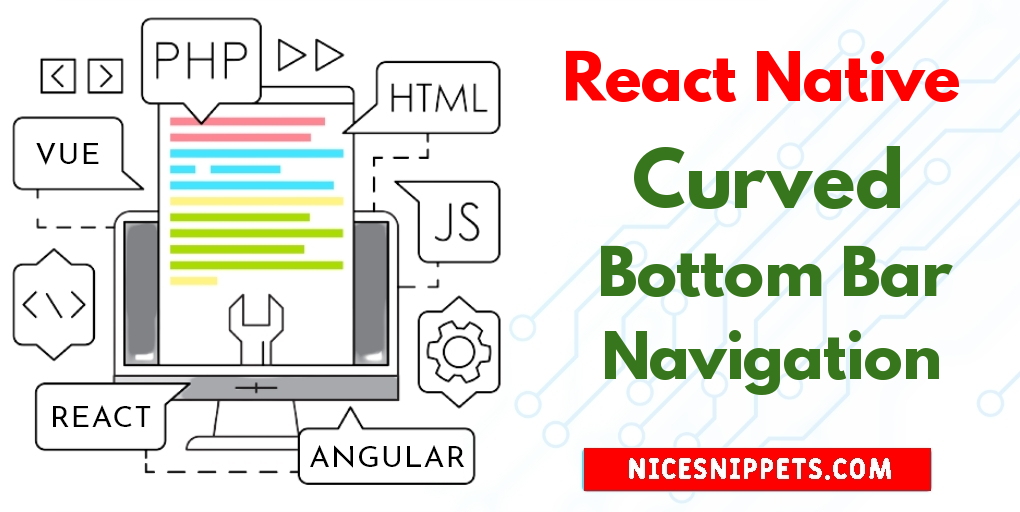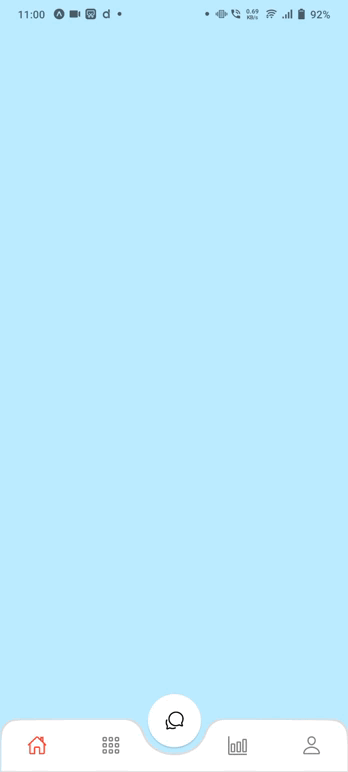04-Apr-2023
.
Admin

Hi Guys,
This article goes in detailed on react native curved bottom bar navigation example. let’s discuss about how to implement curved bottom bar navigation in react native. I would like to show you how to use curved bottom bar navigation in react native. you'll learn curved bottom bar navigation example in react native. So, let's follow few step to create example of how to create curved bottom bar navigation in react native.
In this example, there are 4 screens (Home, Details, Chart, and Profile) defined using the CurvedBottomBar.Screen component. Similarly, you can define as many screens as you like.
Step 1: Download Project
In the first step run the following command to create a project.
expo init ExampleApp
Step 2: Installation and Setup
First, you need to install them in your project:
npm install react-native-curved-bottom-bar --save
Now we need to install react-native-svg and react-native-pager-view.
npm install react-native-svg react-native-pager-view --save
you can set bottom tab icon to install vector icons:
npm i react-native-vector-icons
you have use any bundled Icon.
import this:
import Ionicons from 'react-native-vector-icons/Ionicons';
Step 3: App.js
In this step, You will open the App.js file and put the code.
import React, { useState, useRef } from 'react';
import { StatusBar, StyleSheet, TouchableOpacity, View } from 'react-native';
import { CurvedBottomBar } from 'react-native-curved-bottom-bar';
import Ionicons from 'react-native-vector-icons/Ionicons';
StatusBar.setBarStyle('dark-content');
const App = (props) => {
const ref = useRef();
const [type, setType] = useState('down');
const onClickButton = () => {
if (type === 'up') {
setType('down');
} else {
setType('up');
}
}
const _renderIcon = (routeName: string, selectedTab: string) => {
let icon = '';
switch (routeName) {
case 'Home':
icon = 'ios-home-outline';
break;
case 'Details':
icon = 'apps-outline';
break;
case 'Chart':
icon = 'bar-chart-outline';
break;
case 'Profile':
icon = 'person-outline';
break;
}
return (
<Ionicons name={icon} size={23} color={routeName === selectedTab ? '#FF3030' : 'gray'} />
);
};
return (
<View style={styles.container}>
<CurvedBottomBar.Navigator
ref={ref}
type={type}
height={60}
circleWidth={55}
bgColor="white"
borderTopLeftRight={true}
strokeWidth={2}
swipeEnabled={true}
initialRouteName="title1"
renderCircle={({ selectedTab, navigate }) => (
<TouchableOpacity
style={[type === 'down' ? styles.btnCircle : styles.btnCircleUp]} onPress={onClickButton}
>
<Ionicons name="chatbubbles-outline" size={23} />
</TouchableOpacity>
)}
tabBar={({ routeName, selectedTab, navigate }) => {
return (
<TouchableOpacity
onPress={() => navigate(routeName)}
style={{ flex: 1, alignItems: 'center', justifyContent: 'center' }}>
{_renderIcon(routeName, selectedTab)}
</TouchableOpacity>
);
}}>
<CurvedBottomBar.Screen
name="Home"
position="left"
component={({ navigate }) => <View style={{ backgroundColor: '#BFEFFF', flex: 1 }} />}
/>
<CurvedBottomBar.Screen
name="Details"
component={({ navigate }) => <View style={{ backgroundColor: '#FFEBCD', flex: 1 }} />}
position="left"
/>
<CurvedBottomBar.Screen
name="Chart"
position="right"
component={({ navigate }) => <View style={{ backgroundColor: '#BFEFFF', flex: 1 }} />}
/>
<CurvedBottomBar.Screen
name="Profile"
component={({ navigate }) => <View style={{ backgroundColor: '#FFEBCD', flex: 1 }} />}
position="right"
/>
</CurvedBottomBar.Navigator>
</View>
);
};
export default App;
const styles = StyleSheet.create({
container: {
flex: 1,
},
btnCircle: {
width: 60,
height: 60,
borderRadius: 30,
alignItems: 'center',
justifyContent: 'center',
backgroundColor: 'white',
shadowColor: "#000",
shadowOffset: {
width: 0,
height: 1,
},
shadowOpacity: 0.20,
shadowRadius: 1.41,
elevation: 1,
bottom: 28
},
btnCircleUp: {
width: 60,
height: 60,
borderRadius: 30,
alignItems: 'center',
justifyContent: 'center',
backgroundColor: '#E8E8E8',
bottom: 18,
shadowColor: "#000",
shadowOffset: {
width: 0,
height: 1,
},
shadowOpacity: 0.20,
shadowRadius: 1.41,
elevation: 1,
},
imgCircle: {
width: 30,
height: 30,
tintColor: '#48CEF6'
},
img: {
width: 30,
height: 30,
},
});
Run Project
In the last step run your project using the below command.
expo start
You can QR code scan in Expo Go Application on mobile.
Output :

It will help you...
#React Native